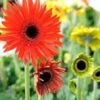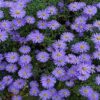**Chrysanthemums and the Art of Flower Arrangement**

Chrysanthemums, with their vibrant colors and intricate blooms, hold a special place in the art of flower arrangement, also known as ikebana in Japanese culture. These versatile flowers, revered for their symbolic meanings and aesthetic appeal, are cherished by floral artists and enthusiasts worldwide for their ability to convey emotions and evoke natural beauty. In the realm of flower arranging, chrysanthemums play a significant role in traditional and contemporary floral compositions, showcasing the harmonious balance between form, color, and symbolism. Let’s explore the fascinating relationship between chrysanthemums and the art of flower arrangement, highlighting their cultural significance and artistic expressions.
**1. Symbolism and Cultural Significance**
Chrysanthemums carry deep symbolism and cultural significance in the art of flower arrangement. In Japanese ikebana, chrysanthemums symbolize longevity, elegance, and the changing seasons. The chrysanthemum is revered as one of the “Four Gentlemen” in Chinese art, representing autumn and integrity. Throughout history, chrysanthemums have been celebrated in art, literature, and traditional ceremonies, embodying enduring themes of beauty and resilience. Floral artists use chrysanthemums to convey sentiments and evoke cultural narratives through carefully crafted arrangements that reflect aesthetic traditions and artistic values.
**2. Versatility in Floral Design**
Chrysanthemums are prized for their versatility in floral design, offering a wide range of colors, shapes, and sizes to complement different styles of arrangements. In classical ikebana, chrysanthemums are used as focal points or structural elements in minimalist compositions that emphasize simplicity and balance. Contemporary floral designers integrate chrysanthemums into innovative arrangements that blend traditional techniques with modern aesthetics. From elegant cascades of spray chrysanthemums to bold clusters of cushion chrysanthemums, these flowers inspire creativity and experimentation in floral artistry.
**3. Seasonal Expressions and Garden Aesthetics**
Chrysanthemums are celebrated for their seasonal expressions and contributions to garden aesthetics. In autumn, chrysanthemums come into full bloom, signaling the transition of seasons and infusing landscapes with vibrant colors. Floral artists incorporate chrysanthemums into seasonal arrangements that capture the essence of autumnal beauty, using warm hues and natural elements to evoke a sense of harmony with nature. Chrysanthemum festivals, such as Japan’s Kiku Matsuri, showcase elaborate displays of chrysanthemum arrangements that celebrate the flower’s cultural heritage and aesthetic allure.
**4. Formalism and Artistic Principles**
The art of arranging chrysanthemums embodies formalism and adherence to artistic principles that govern floral design. In ikebana, practitioners follow established techniques, such as asymmetry, empty space (ma), and the use of natural materials, to create harmonious compositions that reflect seasonal themes and poetic sentiments. Chrysanthemums are arranged according to their inherent characteristics and symbolic meanings, with careful attention to balance, proportion, and rhythm. This disciplined approach to floral artistry elevates chrysanthemums from mere decorations to expressions of profound beauty and cultural resonance.
**5. Spiritual Connections and Meditative Practices**
Chrysanthemum arrangements inspire spiritual connections and meditative practices in the art of flower arrangement. In Japanese tea ceremonies (chanoyu), chrysanthemum arrangements symbolize hospitality and reverence for nature, enriching ceremonial spaces with tranquility and grace. Floral artists engage in mindful practices when arranging chrysanthemums, focusing on the present moment and cultivating a deep appreciation for the transient beauty of flowers. Chrysanthemum arrangements serve as contemplative expressions of impermanence and the cyclical nature of life, resonating with philosophical themes in Eastern aesthetics.
**6. Modern Interpretations and Contemporary Trends**
In contemporary floral design, chrysanthemums continue to inspire modern interpretations and innovative trends in flower arranging. Floral artists experiment with unconventional color palettes, unconventional materials, and sculptural techniques to reimagine traditional chrysanthemum arrangements. Chrysanthemums are integrated into mixed-media installations, immersive floral experiences, and collaborative art projects that redefine the boundaries of floral artistry. By embracing chrysanthemums as a versatile medium for creative expression, contemporary floral designers contribute to the evolution of flower arranging as a dynamic and evolving art form.
**Conclusion**
Chrysanthemums are integral to the art of flower arrangement, embodying cultural symbolism, aesthetic traditions, and artistic expressions. Whether used in classical ikebana or contemporary floral design, chrysanthemums inspire floral artists to create evocative compositions that celebrate nature’s beauty and cultural heritage. The versatility of chrysanthemums in floral design reflects their enduring appeal as symbols of elegance, resilience, and seasonal transitions. By exploring the art of arranging chrysanthemums, we gain a deeper appreciation for the intersection of nature, culture, and creativity in the world of floral artistry.
**Chrysanthemums in Floral Arrangement: A Timeless Art Form**
Chrysanthemums, revered for their beauty and cultural significance, have long been cherished in the art of floral arrangement, which spans across diverse cultures and traditions. From classical ikebana in Japan to contemporary floral design trends worldwide, chrysanthemums continue to inspire floral artists with their versatility, symbolism, and aesthetic appeal. In this exploration of chrysanthemums and the art of flower arrangement, we delve into the profound connections between these captivating blooms and the timeless artistry of floral design.
**1. Traditional Techniques and Cultural Heritage**
Chrysanthemums are integral to traditional techniques of floral arrangement that have been passed down through generations in various cultures. In Japanese ikebana, chrysanthemums are valued for their structural qualities and symbolic meanings. Ikebana practitioners use chrysanthemums as focal points or accents in minimalist compositions that emphasize harmony, balance, and the beauty of imperfection (wabi-sabi). Each arrangement reflects seasonal themes and cultural narratives, highlighting the enduring legacy of chrysanthemums in Japanese floral art.
In Chinese flower arranging, chrysanthemums symbolize autumn and are often featured in arrangements that evoke poetic landscapes and philosophical ideals. The use of chrysanthemums in traditional Chinese art reflects reverence for nature and a deep appreciation for the fleeting beauty of seasonal transitions. Across Asia and beyond, chrysanthemums are revered for their cultural significance and artistic symbolism in the context of flower arranging.
**2. Symbolism and Expressive Meanings**
Chrysanthemums are rich in symbolism and express diverse meanings in the art of floral arrangement. In addition to representing longevity and resilience, chrysanthemums convey sentiments such as joy, elegance, and contemplation. The choice of chrysanthemum cultivars, colors, and arrangement styles conveys specific messages and emotional nuances in floral compositions.
For example, single-flowered chrysanthemums are often used to symbolize simplicity and purity, while pompon chrysanthemums evoke playfulness and whimsy. The color palette of chrysanthemums, ranging from vibrant yellows and oranges to soft pastels and deep burgundies, allows floral artists to create nuanced expressions that resonate with viewers on an emotional level. By harnessing the symbolic power of chrysanthemums, floral designers infuse their arrangements with depth and narrative significance.
**3. Seasonal Variations and Garden Inspirations**
Chrysanthemums inspire seasonal variations and garden-inspired arrangements that celebrate the beauty of nature throughout the year. In autumn-themed compositions, chrysanthemums take center stage, embodying the spirit of the season with their fiery hues and lush textures. Floral artists incorporate elements of the garden, such as branches, leaves, and seed pods, to evoke a sense of place and seasonal transitions.
During spring and summer, chrysanthemums contribute to garden-inspired arrangements that showcase the abundance of the natural world. Soft pastel chrysanthemums paired with blooming roses and verdant foliage create romantic tablescapes and bridal bouquets that capture the essence of a garden in full bloom. By drawing inspiration from seasonal gardens, floral designers reimagine chrysanthemum arrangements as ephemeral expressions of the changing seasons.
**4. Contemporary Trends and Creative Innovations**
In contemporary floral design, chrysanthemums inspire creative innovations and experimental techniques that push the boundaries of traditional flower arranging. Floral artists experiment with unconventional materials, innovative color combinations, and sculptural forms to reinterpret chrysanthemums in bold and unexpected ways. Chrysanthemums are incorporated into large-scale installations, immersive floral experiences, and collaborative art projects that blur the lines between art and nature.
Contemporary floral designers embrace the versatility of chrysanthemums as a medium for artistic expression, challenging conventions and redefining the possibilities of floral design. By embracing innovation and creativity, chrysanthemums remain at the forefront of modern floral aesthetics, captivating audiences with their timeless allure and transformative potential.
**5. Cultural Exchange and Global Influence**
Chrysanthemums facilitate cultural exchange and global influence in the art of floral arrangement, transcending geographical boundaries and fostering artistic dialogue. International floral competitions, workshops, and exhibitions showcase the universal appeal of chrysanthemums as symbols of beauty and cultural heritage. Floral artists from diverse backgrounds draw inspiration from chrysanthemums to create cross-cultural interpretations that celebrate unity in diversity.
Through cultural exchange, chrysanthemums bridge traditions and foster mutual appreciation for floral artistry around the world. By embracing the universal language of flowers, chrysanthemums cultivate connections and inspire collaborations that promote artistic innovation and cultural understanding.
**Conclusion**
Chrysanthemums hold a timeless appeal in the art of floral arrangement, embodying cultural symbolism, expressive meanings, and seasonal inspirations. From traditional techniques rooted in cultural heritage to contemporary innovations that redefine floral aesthetics, chrysanthemums continue to captivate floral artists and enthusiasts alike. By exploring the profound connections between chrysanthemums and the art of flower arrangement, we gain a deeper appreciation for the enduring beauty and cultural significance of these remarkable blooms. Chrysanthemums inspire us to celebrate nature’s bounty and express our creativity through the transformative artistry of floral design.

